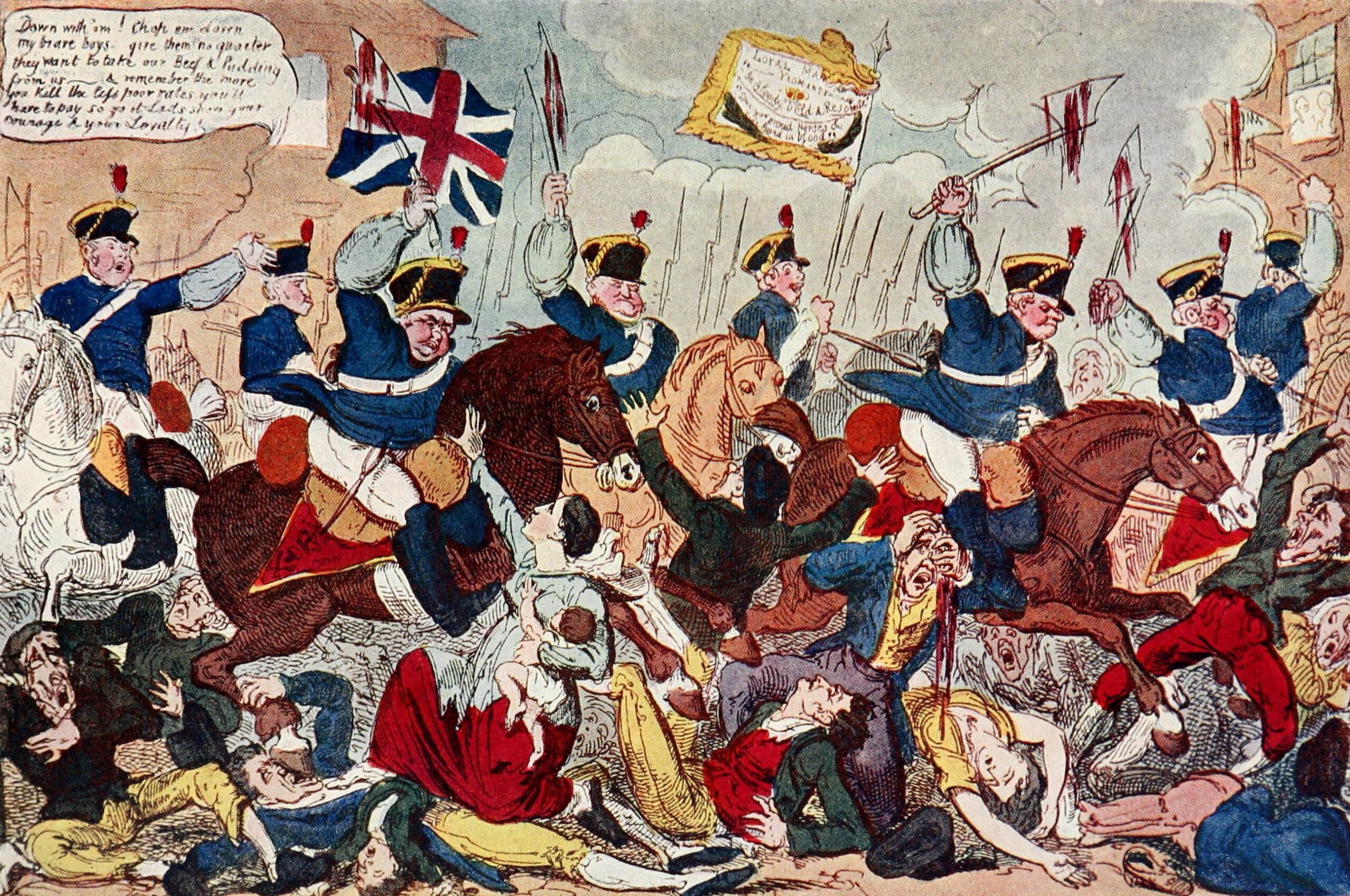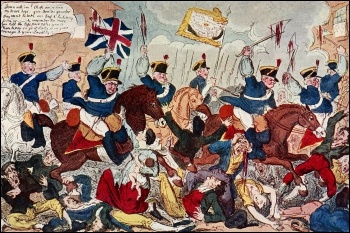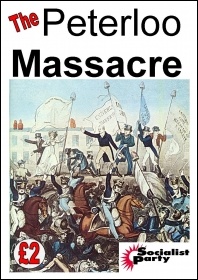Peterloo: “If the people were to rise and smite their enemies, was not this the time?” Samuel Bamford, demonstrator
Hugh Caffrey, Socialist Party national committee
Manchester was England’s second largest and the world’s first industrial city by the early nineteenth century. The industrial revolution had swelled the population, including that of neighbouring Salford, to hundreds of thousands of people by 1819.
But Manchester continued to be run like a mediaeval market town – without even the corrupt trappings of limited parliamentary ‘democracy’ which existed elsewhere.
The main demands of the radical reform movement which grew at this time were for the right to vote for all men (rather than just the rich), annual parliamentary elections, and the introduction of secret ballots.
Under the unreformed system, 152 parliamentary seats had less than 100 voters. Old Sarum constituency in Wiltshire, for example, had seven voters and two MPs. Meanwhile Manchester, with its huge population, had none!
The huge demonstration in St Peters Field on 16 August 1819 was the high point of the working-class part of the radical reform movement, which was demanding democratic rights. For the working-class people who joined the movement, these rights were seen as a means to an end: a better standard of living.
On this day, over 60,000 people gathered on St Peter’s Field in central Manchester. This enormous figure was equivalent to half the adult population of Manchester and Salford.
Thousands assembled from dawn, marching into the local town centres, where they assembled into groups of 100. Prominent among the marchers were female reformers, who had their own contingent from Royton. Sashes, cotton dresses, and the ‘cap of liberty’ were widely worn.
One establishment commentator viewed this organisation of working-class women as “more menacing to the established institutions than the education of the lower orders.”
Peaceful
This was a peaceful and unarmed demonstration. Protesters carried banners and had musical bands. In the words of the request made by leading radical campaigner Henry Hunt, they were “armed with no other weapon than that of a self-approving conscience.”
By contrast, the local authorities had mobilised 1,500 soldiers from yeoman divisions of Cheshire and Manchester & Salford. These were part-time volunteer soldiers, mounted on horseback and armed with swords. They were owners of small businesses, right-wing supporters of ‘King and Church’, violently opposed to any improvement in the lot of the masses.
Manchester’s ruling ‘magistrates’ committee’ was terrified at the well-organised demonstration. They read the Riot Act and ordered the arrest of Henry Hunt and others on the platform, a typical tactic for breaking up mass demonstrations.
The special constables refused to do so without support from the troops. This support was immediately ordered and the yeomanry, many of them drunk, attacked the crowd, hacking and slashing at people and trampling them beneath horses’ hooves.
The 15th Hussars regiment was sent in to strengthen the onslaught and people fleeing were attacked by two infantry regiments as well as an artillery regiment.
Around 15 demonstrators were killed there and then. Over 600 were injured on the day. The largest group were about 250 people trampled beneath charging horses.
The war against Napoleon had culminated in the particularly bloody battle of Waterloo four years earlier, widely known at the time for its huge casualties. The slaughter at St Peter’s Field was soon called ‘Peter Loo’, drawing the comparison with 1815. Within a week, the name ‘Peterloo Massacre’ had been coined.
From the 1790s, radical and trade union organisations and ideas developed. The French revolution had huge support. It’s estimated that a quarter of English workers would rather have fought for France than Britain in the Napoleonic wars which followed it.
Workers’ movement
The nascent workers’ movement of the 1790s was crushed as Britain became a military dictatorship, with martial law, executions, floggings, and transportation – deportation to the colonies to work as forced labour.
The Combination Acts banned trade unions, strikes, collections of money, or oaths of support to workers’ or radical societies. ‘Church and King’ mobs mobilised right-wing supporters in violent attacks on radicals and union activists.
The rural population was devastated by legalised land grabs. Landowners were given the right to build walls around ‘their’ land and to evict the current users, who were driven into the cities ready for super-exploitation by industrialists armed with new technology.
The Black Dwarf, a radical paper, wrote at the time that the worker is “locked up in factories eight storeys high, with no rest till the engines stop and he rushes home to get refreshed for the next day”.
Children over seven worked twelve or fifteen hours a day in factories. The average life expectancy of a Manchester labourer was 17 years. These years were spent living in slums, with no water, no sanitation, epidemics of disease, widespread pollution, and very high child mortality rates.
Periodic strikes and riots alternated with periods of repression. The ‘reform’ and ‘radical’ movements of the time involved several sections of society: the new capitalists of industry, the more progressive section of the middle classes, the mass of the actual working class, and the poorest.
The capitalist class was increasingly divided between old and new capitalists. The latter were criminalised for demanding for the vote. Elite reformers founded the Hampden Club in London in 1811. Prominent reformer Major Cartwright toured northern industrial districts in 1812 and 1813, encouraging the development of popular reform societies.
The old capitalists were split among themselves over free trade or protectionism. This led to the introduction of the Corn Law in 1815 which propped up the price of grain on the domestic market, benefitting rich grain farmers. Grain prices more than doubled in 18 months.
By contrast, the government refused to protect wages: it condemned unions, rejected petitions for a minimum wage, and repealed existing regulations on wages and apprenticeships.
From 1811-16 the widespread ‘Luddite’ workers’ movement developed, opposing the use of new technology to cut pay or jobs. The government used huge military force to put this down with widespread executions and transportations.
In 1815-16 there were widespread strikes, demonstrations and riots. Workers’ resistance to this huge crisis led them to look for political ideas in publications written by middle-class reformers, particularly Cobbett’s Political Register. Riots dropped off, replaced by a mass movement with political ideas.
A petition to parliament signed by 500,000 people was ignored by the government at the start of 1817. The government intended to repeat the 1790s by breaking the movement with massive repression. The national reform leaders failed to react adequately, and the national organisation was broken up.
Manchester increasingly came to the fore as the area with the largest and best-organised mass movement. After repressing the March 1817 ‘Blanketeers’ demonstration, the Manchester authorities decided to set up the Manchester and Salford Yeomanry (MSY), in case the troops were insufficient to put down a larger demonstration.
On 9 June hundreds of Derbyshire workers joined the ‘Pentrich Uprising’, believing they were part of a national insurrection. Tragically they were isolated and arrested before they got far. Three of the leaders were hanged and beheaded, others were imprisoned or transported for life. The underlying mood remained explosive with mass cotton workers’ and miners’ strikes across Lancashire and Cheshire a year later.
The reform movement was led by middle-class people. But, particularly in and around Manchester, it sank deep working-class roots. In June 1819, a conference of delegates from 28 northern towns met in Oldham and called for the “formation of Union Societies in every town and village… and also the frequent holding of public and district meetings.”
Union Societies spread across Lancashire. Under the name ‘Political Protestants’, they developed across Yorkshire. They went on to grow in other manufacturing areas hit by ‘General Distress’ – particularly in the west midlands and north east.
The movement paid special attention to Irish migrants, other sections of the poorest workers, and women. The first of the female reform societies was established on 18 June in Blackburn, where women were a significant part of local workforce.
“Universal Suffrage”
These gave a space to working-class women to organise themselves and discuss their own demands as well as their common struggles with working-class men. A banner at a reform meeting in Leigh on 11 August proclaimed “No Corn Laws, Annual Parliaments and Universal Suffrage”.
“Peaceably if we can, forcibly if we must,” was a slogan widely used in the radical reform movement. On the hills around Manchester, ex-soldiers organised secret night-time drilling as working-class people prepared to confront the state. Tragically, Henry Hunt called on the movement to stop “playing at soldiers” and not be provoked “to commit any breach of the peace”.
Events were developing in a revolutionary direction. Successive demonstrations built morale and were part of a conscious strategy towards a national convention and a national uprising.
Mass organisation was proving more powerful than previous ‘conspiracies’ and Lord Liverpool’s government feared losing control and encouraging a burgeoning working-class movement if they conceded anything.
The backlash against Peterloo mobilised the working-class movement and provoked middle-class ‘public opinion’ into sharper criticism of the government, which was unnerved by these developments. Mass meetings were held across the West Riding – neighbouring parts of east Lancashire and west Yorkshire – and night-time drilling continued.
The intended next steps in the north west were coordinated mass meetings on 1 and 8 November 1819. However, the middle-class limitations of radical reform movement leaders then became sharply apparent. Looking to more passive appeals to public opinion – rather than escalating a mass movement – they called off the demonstrations.
This caused huge confusion in the movement, at which the government then struck. Its spies caused havoc and aided the isolation and arrests of key militants, with Peterloo leaders put on trial.
New laws in November and December banned armed drilling and collection of arms, enabled easier prosecution of radicals, attacked the radical press, and effectively banned radical public meetings and working-class demonstrations. Struggle continued in the 1820s, but at a lower level, in the workplaces.
The working-class was defeated in 1819. Within 12 months, Lancashire activists had concluded that Hunt should have made a stand the previous year. Timing is the art of politics and never more so than in a revolutionary period.
Above all, the idea of an independent workers’ movement separate from all sections of the capitalist establishment had taken firm hold. These hard-learned lessons prepared for Chartism, the world’s first national workers’ movement 20 years later, and remain essential for the movement today.
Review: Peterloo pamphlet
“The sun looked down through a sultry and motionless air…over the whole field were strewn caps, bonnets, shawl and shoes, and other parts of male and female dress, trampled, torn and bloody.”
As the bicentenary of the Peterloo massacre approaches, the publication of this pamphlet by the North West Socialist Party is extremely timely. In six short, crisp chapters, mostly newly written for this publication, the authors set the massacre in the context of the class struggle of the time, as few conventional authors do.
The pamphlet offers a comprehensive analysis of the situation facing working people in the early 1800s: the halving of weavers’ wages, a doubling of grain prices between 1816 and 1817, food riots, the driving of impoverished agricultural labourers into the cities, and so on.
All this was against a background of acute state repression. The workers combine in unions. They strike, rise up and explore every possible tactic. The nascent working class is excluded from the franchise. Rotten boroughs have almost as many MPs as electors. Swelling cities like Manchester, Leeds and Birmingham are totally unrepresented in parliament.
Workers demand the right to vote, yet also strain against private property, the monarchy and the state. With rare exceptions, they are abandoned and disappointed by middle-class radicals. With increasing self-confidence they prepare the ground for what the pamphlet calls ‘the world’s first national workers’ movement’: Chartism.
- The pamphlet is £2 or bulk orders of ten can be bought for £14. Contact Hugh Caffrey at [email protected] or 07769 611 320.










